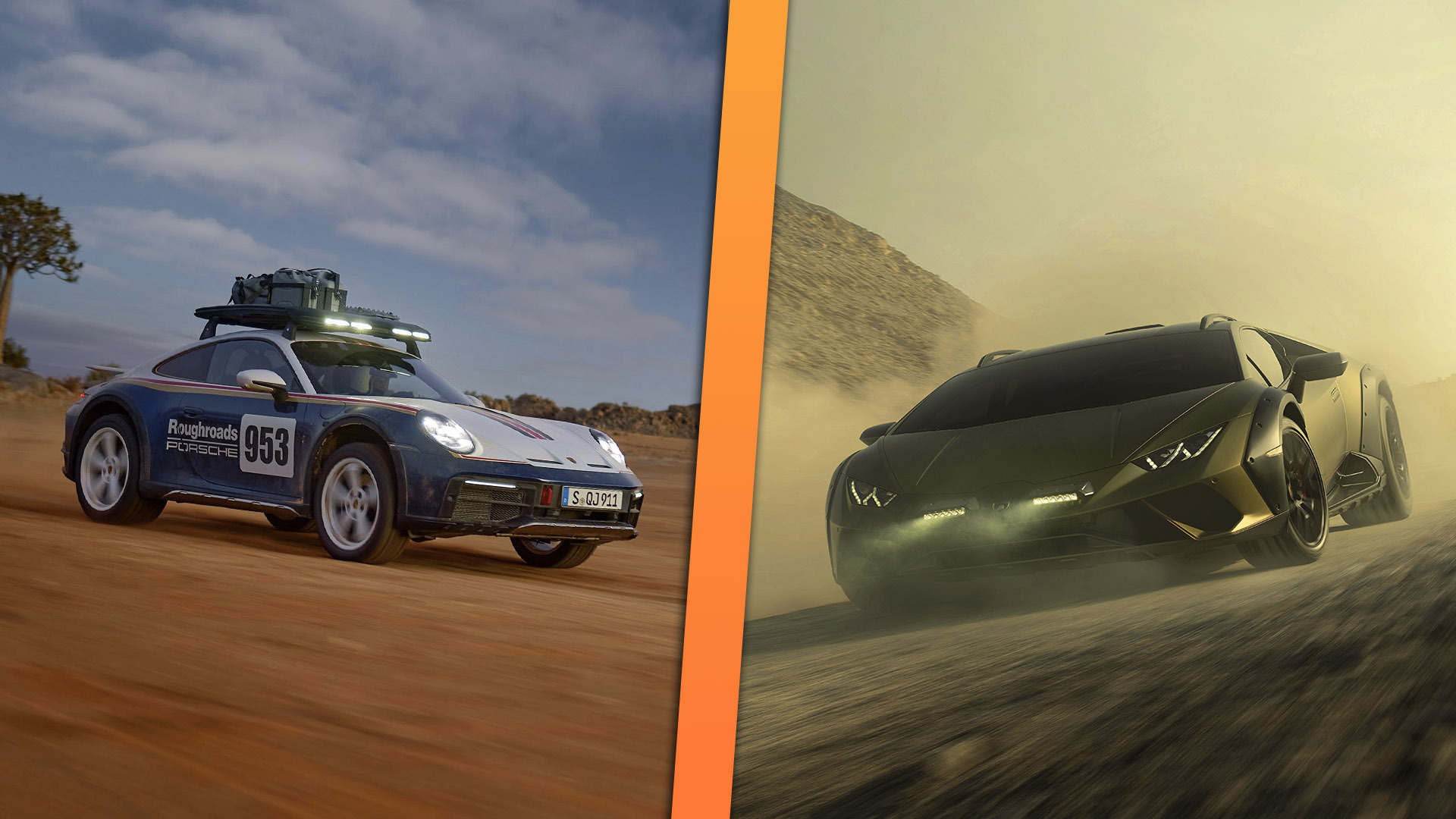

Wednesday saw the full reveal of the Lamborghini Huracán Sterrato, a factory-lifted Huracán with black fenders, LED driving lights, chunky tires (well, chunky by Lambo standards, at least), and freakin’ roof rails. Coincidentally or not, Porsche also recently unveiled its own off-road sports car in the 911 Dakar, a $225,000 factory battle buggy featuring all-terrain tires, lifted suspension, an optional Rothmans-inspired livery, and an entire roof rack capable of supporting a tent.
Essentially, they are the Lambo and Porsche for those who would like an off-roady Lambo or Porsche but are way too cool for the Urus or Cayenne.
With the two VW Group products being so close in spirit, they’ll almost undoubtedly be the subjects of countless comparison road tests (and off-road tests) sooner or later, but before we can do that, we thought it would be interesting to see how they compare on paper.

2023 Lamborghini Huracán Sterrato Specs
- Starting Price: ~$270,000 in Europe
- Engine: 5.2-liter naturally aspirated V10 | 7-speed dual-clutch automatic | all-wheel drive with rear mechanical self-locking differential
- Horsepower: 602 @ 8,000 rpm
- Torque: 417 lb-ft @ 6,500 rpm
- Curb Weight: 3,241 pounds dry
- 0 to 62 mph: 3.4 seconds
- Top Speed: 162 mph
- Production run: 1,499 units

2023 Porsche 911 Dakar Specs
- Starting Price: $223,450
- Engine: 3.0-liter twin-turbo flat-six | 8-speed PDK automatic | all-wheel drive with PTM and electronically controlled differential lock
- Horsepower: 473 @ 6,500 rpm
- Torque: 420 lb-ft @ 2,300 to 5,000 rpm
- Curb Weight: 3,552 pounds
- 0 to 62 mph: 3.4 seconds (0 to 60 mph in 3.2 seconds)
- Top Speed: 149 mph (with summer tires)
- Production run: 2,500 units
Let’s start with price. Porsche has set the 911 Dakar’s starting MSRP at precisely $223,450 after destination. Lamborghini, meanwhile, hasn’t released an official U.S. price yet but the Huracán Sterrato will cost the equivalent of about $270,000 in Europe. Makes sense that the car with the arguably fancier badge would cost more, but, of course, these being limited-run high-demand ultra-luxury goods—only 2,500 Dakars are being made alongside 1,499 Sterratos—don’t expect many buyers to actually pay sticker price.
Behind their respective passenger compartments sit the same engines these two nameplates are famous for. The Huracan sticks with its gloriously naturally aspirated 5.2-liter V10 while the Porsche is powered by the company’s 3.0-liter twin-turbo flat-six. Both cars use dual-clutch automatic transmissions, all-wheel drive, and a locking diff of some variation.

Peak torque figures are very similar, with the Porsche offering 420 lb-ft and the Lambo putting out 417 lb-ft, but because the 911 is turbocharged, its torque comes on much earlier at 2,300 rpm versus the Huracán’s 6,500 rpm. The Lamborghini makes up for it with more horsepower, though, pushing out 602 hp near the top of its rev range, a good whack more than the Porsche’s 473. The Porsche also appears to be heavier by a few hundred pounds although because Lambo is only quoting a dry weight whereas the 911’s stat presumably accounts for fluids, that’s not really an apples-to-apples comparison.
Nevertheless, both cars appear to hit 62 mph in the exact same time: 3.4 seconds. However, the Lamborghini boasts a higher top speed, 162 mph over the Porsche’s summer tire-required 149.

On paper, then, the Huracán Sterrato and 911 Dakar are quite close despite using very different engines. Acceleration should be near-identical (look for the inevitable YouTube drag races to confirm or dispel that theory), but if we had to give one car the edge, the Sterrato does seem to be a bit more extreme. It’s more powerful, has a higher top speed, presumably lighter, and will be more exclusive.
How the two fare on a rally stage is something that’s quite a bit harder to suss out via specs alone, though, and hopefully we’ll get to explore that very soon.
Got a tip or question for the author? You can reach him here: chris.tsui@thedrive.com